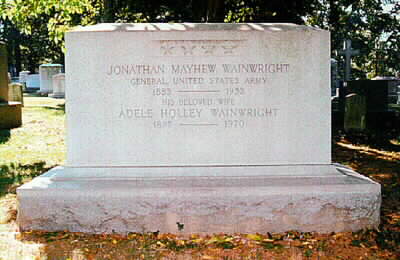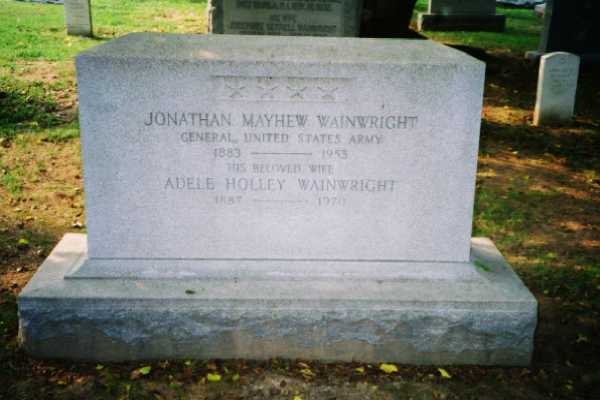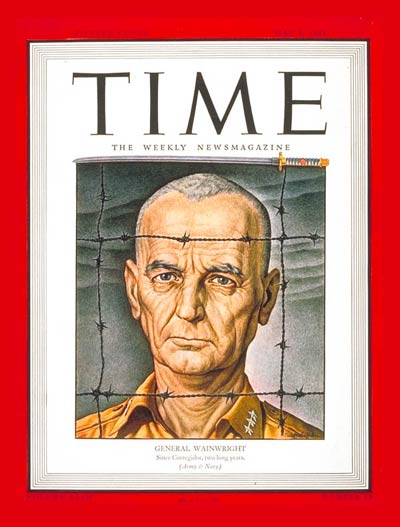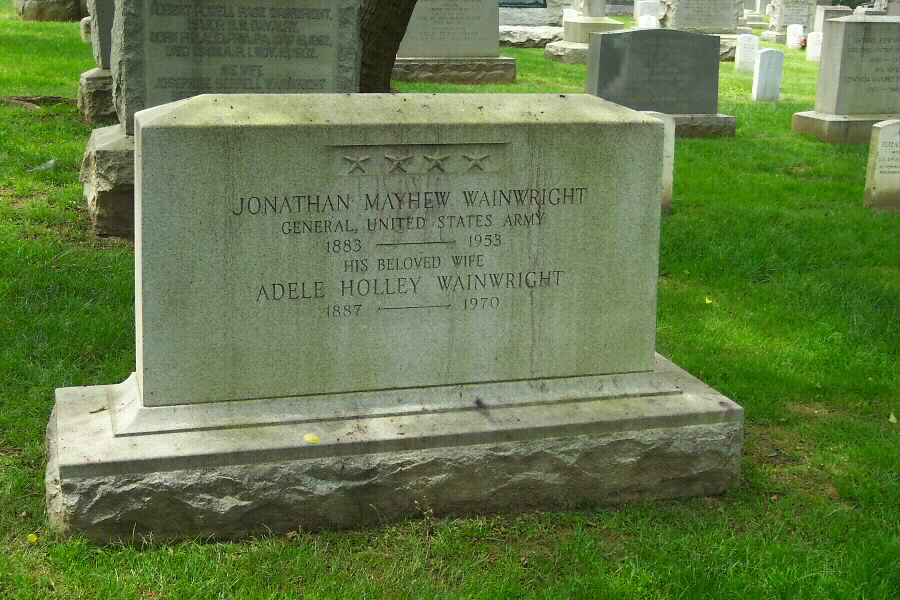General Wainwright was born August 23, 1883, at Fort Walla Walla, Washington, the son of a U.S. Army officer and a descendant in a line of distinguished U. S. Naval officers.
He graduated from the United States Military Academy At West Point in 1906, and was commissioned in the cavalry. Over the next several years he served with the 1st Cavalry in Texas, 1906-08; in the Philippines, where he saw action against Moro rebels, 1908-10; and at various posts in the West.
He graduated from the Mounted Service School, Fort Riley, Kansas, 1916. Promoted to Captain, and in 1917 was on staff of the first officers training camp at Plattsburg, New York. In February 1918 he was ordered to France. In June he became Assistant Chief-of-Staff of the 82nd Infantry Division, with which he took part in Saint Mihiel and Meuse-Argonne offensives. Promoted to temporary Lieutenant Colonel in October he was assigned to occupation duty in Germany with the 3rd Army until 1920, in which year, having reverted to Captain, he was promoted to Major.
After a year as an instructor at the renamed Cavalry School at Fort Riley, he was attached to the General Staff during 1921-23 and assigned to the 3rd Cavalry, Fort Myer, Virginia, 1923-25. He was promoted to Lieutenant Colonel in 1929 and graduated from the Command and General Staff School, Fort Leavenworth, Kansas, 1931, and the Army War College in 1934. He was promoted to Colonel in 1935, and commanded the 3rd Cavalry until 1938, when he was advanced to Brigadier General in command of the 1st Cavalry Brigade at Fort Clark, Texas.
In September 1940, he was promoted to temporary Major General and returned to the Philippines to take command of the Philippine Division. As the senior field commander of US and Filipino forces under Douglas MacArthur, he had tactical responsibility for resisting the Japanese invasion that began in late December 1941. Pushed back from beachheads in Lingayen Gulf, his Philippine forces withdrew onto the Bataan Peninsula early in January 1942, where they occupied well prepared defensive positions and commanded the entrance to Manila Bay. In throwing back a major Japanese assault in January the defenders earned name of “battling bastards of Bataan.” When MacArthur was ordered off Bataan in March 1942, Wainwright, promoted to temporary Lieutenant General, succeeded to command of US Army Forces in the Far East, a command immediately afterward redesignated US Forces in the Philippines. The Japanese attacks resumed in earnest in April.
A Small core of the now starving, ill and unsupplied garrison pulled farther back onto island fortress of Corregidor, leaving 70,000 defenders on Bataan to surrender on April 9. The Japanese gained a foothold on Corregidor on May 5 against a furious defense, and the next day he was forced to surrender the 3500 men on the island. Under orders that he was forced to broadcast, local commanders elsewhere in the Philippines surrendered one by one, and on June 9 the US command in the Philippines ceased to exist.
He was then held in prison camps in northern Luzon, Formosa, and Manchuria until he was liberated by Russian troops in August 1945. After witnessing the Japanese surrender aboard the USS Missouri on September 2, he returned to the Philippines to receive the surrender of the local Japanese commander. A hero's welcome in the US was accompanied by promotion to General and the awarding of the Medal of Honor. “Memoir, General Wainwright's Story,” was published in 1945.
In January 1946 he took command of the 4th Army, Fort Sam Houston, Texas. He retired from active duty in August 1947 and died at San Antonio, Texas, September 2, 1953.
He was the son of Robert Powell Page Wainwright, a career Cavalry officer who died in service in the Philippines. He is buried next to his father in Section 1 of Arlington National Cemetery. He is one of only a few people in history whose funeral was held in lower level of the Memorial Amphitheater. Others were Sir Moses Ezekiel, creator of Confederate Memorial, March 30, 1921; Colonel Charles Young, an early black graduate of West Point, June 1, 1923; Ignace Jan Paderewski, exiled President of Poland, July 5, 1941; General of the Armies John J. Pershing, July 19, 1948; Secretary of Defense James V. Forrestal, May 25, 1949; and General Henry “Hap” Arnold, January 18, 1950.
His wife, Adele Holley Wainwright (1887-1970) is buried with him.
WAINWRIGHT, JONATHAN M.
Rank and organization: General, Commanding U.S. Army Forces in the Philippines. Place and date: Philippine Islands, 12 March to 7 May 1942. Entered service at: Skaneateles, N.Y. Birth: Walla Walla, Washington. GO. No.: 80, 19 September 1945.
Citation
Distinguished himself by intrepid and determined leadership against greatly superior enemy forces. At the repeated risk of life above and beyond the call of duty in his position, he frequented the firing line of his troops where his presence provided the example and incentive that helped make the gallant efforts of these men possible. The final stand on beleaguered Corregidor, for which he was in an important measure personally responsible, commanded the admiration of the Nation's allies. It reflected the high morale of American arms in the face of overwhelming odds. His courage and resolution were a vitally needed inspiration to the then sorely pressed freedom-loving peoples of the world.


Michael Robert Patterson was born in Arlington and is the son of a former officer of the US Army. So it was no wonder that sooner or later his interests drew him to American history and especially to American military history. Many of his articles can be found on renowned portals like the New York Times, Washingtonpost or Wikipedia.
Reviewed by: Michael Howard



